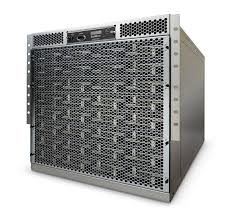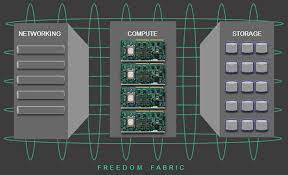AMD Evolving Fast to Survive in the Server Market Jungle
by Johan De Gelas on June 18, 2013 6:00 AM EST- Posted in
- AMD
- CPUs
- Arm
- Enterprise
Low Power Server CPUs
When you read about micro servers, the spotlights are on very low power servers with Atom and ARM servers. The reality in the server market is however very different. But as you probably understand from the reasoning above, a server with an Atom CPU or ARM CPU is hardly a good solution for the homogenous webfarms.
In fact, with the exception of Seamicro, many micro servers have utterly failed in that market. Quite a few server vendors have offered dense Atom based solutions, but those solutions were poorly received. Simply cramming tens of Atom based servers in a small chassis is a pretty bad idea:
1. The single threaded performance of the Atom is even for webfarms too low
2. The power gains that you make by using lower power CPUs are negated by the cable management costs, the higher amount of PCBs and PHYs.
To sum it up: the performance per watt of those servers did not and will not thrill anyone. Seamicro, the pioneer of this niche market, was successful despite and not thanks to the Atom processor inside it’s micro servers. When Seamicro offered Low Power Xeons instead of Atoms inside their Borg Cube inspired server, the demand for their products really took off.

And even Calxeda, the champion of the low power servers admits that the current “ultra low power but low performance” microserver market is a small one. Calxeda has high expectations for its next generation of servers as they will be based on the more powerful Cortex A15 and A57 CPUs.
Seamicro and Calxeda succeeded where others fails as they understood that an optimized PCB and network fabric was necessary to make the concept of micro server work. Seamicro reduced the serverboard to its bare minimum (“credit card size”), turned unnecessary features off and connected all I/O via a high performance 3D torus interconnect.

Calxeda integrated several servers on one PCB and connected them together with a 2D torus network fabric. The result was a low power draw per server, not just per CPU. Once you add a CPU with good enough single threaded performance, things get very interesting.










80 Comments
View All Comments
1008anan - Tuesday, June 18, 2013 - link
Do you really think Seattle will hit the market in Q1 2014? Count me skeptical. Seattle will have lower single threaded performance than Avoton. Plus Seattle can't process native X86 code the way Avoton can.Wilco1 - Tuesday, June 18, 2013 - link
Seattle will sample in Q1 and be available in Q3 according to other articles.Note A57 is much faster than Avoton, even A15 has better IPC. Given Seattle packs 4 times as many cores, we're talking about 5-6 times the throughput of Avoton.
milli - Tuesday, June 18, 2013 - link
Wilco1, it's beautiful how you can make definite conclusion based on nothing.All we know now are estimates. But if you would even take these estimates into consideration then things won't be as rosy as you describe them.
- A57 will be around 20-30% faster then A15 on the same process. Numbers from ARM themselves. In one of Anand's reviews, AMD's Bobcat core was faster than a A15.
- Intel's press release on Silvermont: "Silvermont microarchitecture delivers ~3x more peak performance or the same performance at ~5x lower power over current-generation Intel Atom processor core"
Considering that the newest Atom SOC's aren't that much slower than AMD's Bobcat core, a sane person wouldn't have said what you just said.
Wilco1 - Tuesday, June 18, 2013 - link
Let's start with the facts, shall we? We already know A15 beats current Atoms by a huge margin on native code:http://browser.primatelabs.com/geekbench2/compare/...
Let's assume Silvermont will do 3 times the score, so ~4300 (I don't believe it will but that's another discussion). A57 has 20-30% better IPC as you say, and clocks up to 2.5GHz, so would score ~7300. That means with 4x the cores Seattle would have 6.8 times the throughput. Round it down to 5-6 times because we're talking about estimates. Any sane person would agree with my calculation. Avoton has no chance to compete on throughput, not even with 8 cores. Period.
Btw A15 easily beats Bobcat and trades blows with Jaguar (beats it on overall score, wipes it out on FP but is slower on int and memory - remember this is a phone SoC!): http://browser.primatelabs.com/geekbench2/compare/...
milli - Tuesday, June 18, 2013 - link
You're comparing a dual core Atom to a quad core A15!http://browser.primatelabs.com/geekbench2/compare/...
If it wasn't for the Neon unit kicking ass in some tests, the scores would be pretty close. Since Silvermont will support SSE4.1 & SSE4.2, it will become stronger in that department.
The first Seattle will be a 8-core part. The 16-core one will follow later but AMD is not precise with the release date.
Geekbench is a very low level benchmark that runs mostly in the processor cache. Many things that make or a break a processor are not tested in this way. It's not true indicator of real world performance.
http://images.anandtech.com/graphs/graph6877/53966...
Here you have an example where a 1.6Ghz dual core bobcat beats a 1.7Ghz dual core A15 by almost 20% in a real world cpu intensive test. Just to show that Geekbench is very low-level and thing like prefetchers, branch predictors, ... are not tested very well.
But as I said, it's too soon to speculate. That's all I'm saying.
Wilco1 - Wednesday, June 19, 2013 - link
Atom supports hyperthreading which gives a big speedup so it is reasonable to compare with a quad core - note most phones are quad-core anyway. But as you show even a dual A15 beats a dual Atom by almost a factor of 2 despite running at a lower frequency. I don't know whether NEON is used at all, but I'd be surprised if it was.Geekbench is not perfect but it correlates well with other native benchmarks such as SPEC and Phoronix. Your physics example is comparing hand optimized drivers for different GPUs. The A15 is trivially beaten by the Note 2 (quad A9) despite having ~3 times the NEON FP performance. So I'm not sure whether one can conclude anything from that beyond that AMD's drivers appear to be well optimized.
milli - Wednesday, June 19, 2013 - link
3DMark physics runs completely on the CPU. The GPU is not used at all. The fact that the Note 2 beats the dual A15, shows ones more that low level benchmarks like GB and SPEC are almost meaningless between architectures.Also, I don't agree that you should compare a dual core HT Atom to a quad core. It's still a dual core. That A15 beats a 5 year old Atom core by a factor of 2 is no feat. It's the minimum.
Yes, Geekbench is compiled to use ARM's Neon.
Wilco1 - Wednesday, June 19, 2013 - link
Yes I know the physics test runs on the CPU. Without having access to the source code it would be hard to say what causes it. If it doesn't use Neon and has a high correlation with #cores * MHz then that might explain it. Btw where did you get that Geekbench uses Neon? Which benchmarks are actually vectorized?A dual Atom has 4 threads. A 2-module Bulldozer has 4 threads. A quad core has 4 threads. These are ways of supporting 4 threads with different hardware tradeoffs. However from the software perspective they look and behave in the same way. So it's entirely reasonable to compare thread for thread.
Btw if you think the dual A15 vs Atom speedup of ~2x is low, you'll be disappointed with Silvermont. Since the claimed 2.8x speedup is for a quad core, a dual Silvermont will only be ~1.4 times faster...
rocketbuddha - Thursday, June 20, 2013 - link
AMD APU is on Windows Full version.A15 SOCs are in Android mobile version.
Not at all equivalent.
1008anan - Tuesday, June 18, 2013 - link
Wilco, Avoton's 14 nm shrink (airmont) is likely released in Q4, 2014. Seattle will be available in Q3, 2014. Seattle should really be compared to airmont.Avoton has better branch predictors and macro fusion than A57. Some Avoton SoCs will pack 20 Silvermont cores.
"Given Seattle packs 4 times as many cores, we're talking about 5-6 times the throughput of Avoton." :LOL:
Silvermont and Airmont cores are more power efficient than A57 cores.